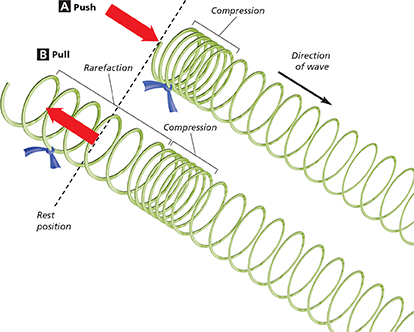Quick Lab
Observing Waves in a Medium
Procedure
Fill a large, clear, square or rectangular container halfway with water. Add a drop of food coloring in the center of the container.
At the side of the container, submerge a ruler length-wise. Move the ruler up and down to make waves.
Observe and record how the waves and the food coloring move.
Analyze and Conclude
Comparing and Contrasting Compare the movement of the waves with the movement of the food coloring.
Formulating Hypotheses Generate one or more hypotheses to explain the observed motion of the food coloring.
Longitudinal Waves
Figure 3 shows a wave in a spring toy at two points in time. To start the wave, add energy to the spring by pushing and pulling the end of the spring. The wave carries energy along the spring from left to right. You can see in Figure 3A that when the wave starts, some of the coils are closer together than they would be in the rest position. An area where the particles in a medium are spaced close together is called a compression (kum PRESH un). As the compression moves to the right in Figure 3B, coils behind it are spread out more than they were in the rest position. An area where the particles in a medium are spread out is called a rarefaction (rehr uh FAK shun).
Look at the ribbon tied to one of the coils. The ribbon is first in a compression and then in a rarefaction. However, the ribbon and the coil it is tied to do not move along the spring. As compressions and rarefactions travel along the spring toward the right, each coil vibrates back and forth around its rest position. In this wave, the vibration is a backand-forth motion of the coil that is parallel to, or in the same direction as, the direction in which the wave moves. This is a longitudinal wave. A longitudinal wave (lawn juh TOO duh nul) is a wave in which the vibration of the medium is parallel to the direction the wave travels.
Waves in springs are not the only kind of longitudinal waves. P waves (originally called primary waves) are longitudinal waves produced by earthquakes. Because P waves can travel through Earth, scientists can use these waves to map Earth's unseen interior.
 What are compressions and rarefactions?
What are compressions and rarefactions?
Figure 3 A longitudinal wave causes the medium to vibrate in a direction parallel to the direction in which the wave travels. Each point on the spring vibrates back and forth about its rest position. A When the end of the spring is pushed, a compression starts to move along the spring. B When the end of the spring is pulled, a rarefaction follows the compression along the spring.
 d
d



